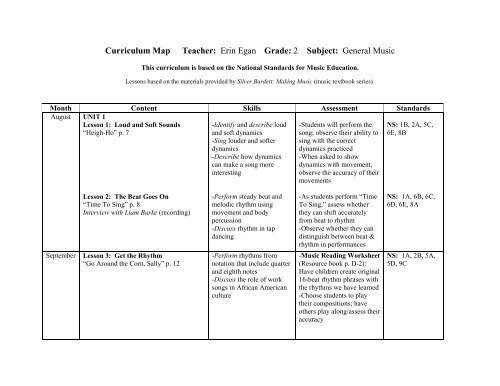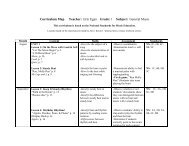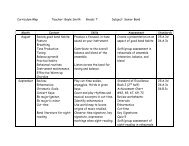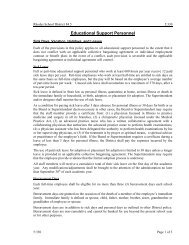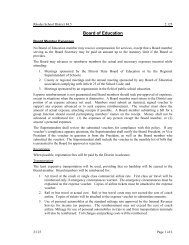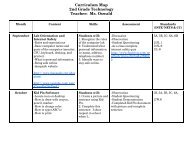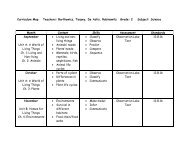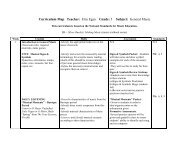Vocal Music Grade 2
Vocal Music Grade 2
Vocal Music Grade 2
Create successful ePaper yourself
Turn your PDF publications into a flip-book with our unique Google optimized e-Paper software.
Curriculum Map<br />
Teacher: Erin Egan <strong>Grade</strong>: 2 Subject: General <strong>Music</strong><br />
This curriculum is based on the National Standards for <strong>Music</strong> Education.<br />
Lessons based on the materials provided by Silver Burdett: Making <strong>Music</strong> (music textbook series).<br />
Month Content Skills Assessment Standards<br />
August UNIT 1<br />
Lesson 1: Loud and Soft Sounds<br />
“Heigh-Ho” p. 7<br />
NS: 1B, 2A, 5C,<br />
6E, 8B<br />
-Identify and describe loud<br />
and soft dynamics<br />
-Sing louder and softer<br />
dynamics<br />
-Describe how dynamics<br />
can make a song more<br />
interesting<br />
-Students will perform the<br />
song; observe their ability to<br />
sing with the correct<br />
dynamics practiced<br />
-When asked to show<br />
dynamics with movement,<br />
observe the accuracy of their<br />
movements<br />
Lesson 2: The Beat Goes On<br />
“Time To Sing” p. 8<br />
Interview with Liam Burke (recording)<br />
-Perform steady beat and<br />
melodic rhythm using<br />
movement and body<br />
percussion<br />
-Discuss rhythm in tap<br />
dancing<br />
-As students perform “Time<br />
To Sing,” assess whether<br />
they can shift accurately<br />
from beat to rhythm<br />
-Observe whether they can<br />
distinguish between beat &<br />
rhythm in performances<br />
NS: 1A, 6B, 6C,<br />
6D, 6E, 8A<br />
September<br />
Lesson 3: Get the Rhythm<br />
“Go Around the Corn, Sally” p. 12<br />
-Perform rhythms from<br />
notation that include quarter<br />
and eighth notes<br />
-Discuss the role of work<br />
songs in African American<br />
culture<br />
-<strong>Music</strong> Reading Worksheet<br />
(Resource book p. D-2):<br />
Have children create original<br />
16-beat rhythm phrases with<br />
the rhythms we have learned<br />
-Choose students to play<br />
their compositions; have<br />
others play along/assess their<br />
accuracy<br />
NS: 1A, 2B, 5A,<br />
5D, 9C
September<br />
cont.<br />
Lesson 4: Rhythms at Rest<br />
“Silver Moon Boat” p. 14<br />
“Xiao yin chuan” p. 14<br />
-Read and perform quarter<br />
note, eighth notes, and<br />
quarter rests in a song<br />
-Discuss the Chinese Moon<br />
Festival and songs that are<br />
sung as a part of it<br />
--<strong>Music</strong> Reading<br />
Worksheet (Resource book<br />
p. D-3): Have children<br />
create their own phrases<br />
with rhythms learned<br />
-Observe their rhythmic<br />
accuracy as students perform<br />
the song “Silver Moon Boat”<br />
NS: 1C, 2B, 5A,<br />
5D, 6E<br />
<strong>Music</strong> Theory, <strong>Grade</strong> 2:<br />
Lesson 1 – Low & High<br />
Lesson 3 – Up & Down<br />
-Identify pictures that best<br />
match the pitch that sounds<br />
-Identify the contour of a<br />
melody by circling the most<br />
accurate picture<br />
-Students will submit these<br />
worksheets for a graded<br />
assessment<br />
NS: 5, 6<br />
Lesson 6: Let the Spirit Move You<br />
“Michael, Row the Boat Ashore” p. 18<br />
-Move to show the different<br />
sections in a call-andresponse<br />
song<br />
-Discuss African-American<br />
spirituals as they relate to<br />
history and culture<br />
-Have children sing the<br />
song; encourage them to<br />
move, and observe that they<br />
use one movement for the<br />
call and another for the<br />
response<br />
NS: 1A, 1B, 6A,<br />
6E, 9B<br />
Lesson 7: Up and Down the <strong>Music</strong> Trail<br />
“Lone Star Trail” p. 20<br />
Buckaroo Holiday (recording), listening<br />
map p. 23<br />
-Listen to a melody with<br />
high and low pitches<br />
-Identify high and low<br />
pitches in music notation<br />
-Observe whether students<br />
can identify high and low<br />
pitches in notation and on a<br />
listening map<br />
NS: 1B, 2B, 2F,<br />
5B, 6B, 6E, 8B,<br />
9D
October<br />
Lesson 8: Follow the Direction<br />
“My Father’s House” p. 25<br />
(listening map, p. 24)<br />
-Sing a melody while<br />
moving to indicate changes<br />
in direction<br />
-Explore and discuss gospel<br />
music<br />
-Observe accuracy of student<br />
movements to show the<br />
pitches of the melody<br />
moving downward, upward,<br />
and repeating<br />
NS: 1B, 6B, 9A<br />
Lesson 9: Three Pitches<br />
“Lucy Locket” p. 27<br />
-Read and sing the pitches<br />
sol, mi, and la from notation<br />
-Have children read text at<br />
bottom of p. 27 and answer<br />
the question<br />
-Ask them to read and sing<br />
melodic excerpt using pitch<br />
syllables and hand signs;<br />
assess accuracy of the<br />
performance<br />
NS: 1A, 1E, 5B,<br />
6C, 8B, 9C<br />
Lesson 10: Read Pizza, Play Pizza<br />
“Pizza, Pizza, Daddy-O” pp. 28-29<br />
-Identify sol, mi, and la in<br />
different staff locations<br />
-Discuss a fine art painting<br />
that represents children<br />
playing a singing game<br />
-Have children sing patterns<br />
1 & 2 in “Show What You<br />
Know!” (on p. 31)<br />
-Ask them to show where<br />
the pitches are on the staff,<br />
observe their accuracy<br />
NS: 2D, 5B, 5D,<br />
8B<br />
Lesson 11: You Are the <strong>Music</strong><br />
“Down, Down, Baby” pp. 32-33<br />
-Listen for and identify vocal<br />
and body percussion sounds<br />
in the accompaniment of a<br />
song<br />
-Discuss and describe<br />
hambone style<br />
-Journal Writing: while<br />
children listen to “Down,<br />
Down, Baby,” they should<br />
write down the vocal sounds<br />
and body percussion they<br />
can hear<br />
-Collect these answers to<br />
assess their listening skills<br />
NS: 1C, 3D, 6B,<br />
6D, 7B, 9D<br />
Lesson 12: Thin to Thick<br />
“Riddle Ree” p. 34<br />
-Identify thin and thick<br />
texture through performing<br />
a speech piece with multiple<br />
ostinatos<br />
-Describe what an ostinato<br />
-Have children perform in<br />
groups using all three parts<br />
(song plus two ostinatos)<br />
-Ask other children to<br />
describe the texture<br />
NS: 1A, 1D, 4B,<br />
6B
October<br />
cont.<br />
is and why it is useful in<br />
music<br />
accurately<br />
Lesson 1: Speed Up, Slow Down<br />
“Miss Mary Mack” p. 42<br />
-Move to a song that gets<br />
faster and slower<br />
-Hand Game: Students will<br />
play with partners,<br />
maintaining steady beat even<br />
when the tempo changes<br />
occur<br />
-Observe that the children<br />
recognize the tempo changes<br />
move faster/slower when<br />
necessary to match the song<br />
NS: 1B, 6E, 8A<br />
UNIT 12<br />
Lesson 2: Ooh, It’s Halloween!<br />
“Skin and Bones” p. 376<br />
“The Owl and the Pumpkin” p. 377<br />
Pumpkin Picking, p. 376<br />
November <strong>Music</strong> Theory, <strong>Grade</strong> 2:<br />
Lesson 4 – Lines & Spaces<br />
Lesson 5 – Line/Space Numbers of Notes<br />
Lesson 6 – Fun Sheet: <strong>Music</strong>al Alphabet<br />
Lesson 7 – Steps, Skips, Repeated Notes<br />
-Sing two Halloween songs<br />
with appropriate dynamic<br />
mood changes and contrast<br />
-Perform a Halloween poem<br />
with dynamic expression<br />
-Read and notate symbols<br />
on the lines & spaces of the<br />
staff<br />
-Identify letter names in the<br />
musical alphabet<br />
-Notate steps, skips, and<br />
repeated pitches<br />
-Observe that students use<br />
dynamic expression in their<br />
singing (while performing<br />
both songs)<br />
-Students will submit these<br />
worksheets as a graded<br />
assessment<br />
NS: 1A, 1B, 1E<br />
NS: 4, 5, 6<br />
UNIT 2<br />
Lesson 3: Pick a Pattern<br />
“Four in a Boat” p. 46<br />
Allegro non troppo, No. 33 (recording)<br />
-Play rhythm patterns that<br />
include quarter notes, eighth<br />
notes, and quarter rests<br />
-Observe and discuss<br />
rhythm in visual arts<br />
-Class should clap rhythms<br />
on p. 49 to show their<br />
knowledge, then play on<br />
percussion instruments<br />
-Observe performances to<br />
determine their<br />
understanding of the<br />
rhythms<br />
NS: 2A, 4C, 5A,<br />
6A, 6E, 8B
November<br />
cont.<br />
Lesson 4: Get on the Beat<br />
“Way Down in the Schoolyard” p. 50<br />
“Way Down Yonder in the Brickyard” p.<br />
51<br />
-Move on the strong beats<br />
while listening and singing<br />
-Discuss the importance of<br />
preserving cultural heritage<br />
in music<br />
-Compare and contrast two<br />
versions of the same song<br />
-Observe that students know<br />
where the strong beats occur<br />
in the song; have students<br />
move on those strong beats<br />
while singing<br />
NS: 1B, 6B, 7A<br />
UNIT 12<br />
Lesson 4: Celebrate Thanksgiving<br />
“Thanksgiving is Near” p. 380<br />
Setting the Thanksgiving Table, p. 381<br />
-Create a verse that fits the<br />
rhythm patterns of a song<br />
-Read and explore rhythm in<br />
a Thanksgiving poem<br />
-Play an ostinato pattern<br />
throughout the song<br />
-Have student groups present<br />
and perform their new verse<br />
of the song; the whole class<br />
can assess the success of<br />
these performances<br />
NS: 1A, 2B, 3B<br />
UNIT 2<br />
Lesson 9: Melodic Pathways<br />
“Down the Ohio” pp. 60-61<br />
Shenandoah (recording), listening map on<br />
pp. 62-63<br />
-Identify the skips, steps,<br />
and repeated pitches in a<br />
song and a listening<br />
selection<br />
-Ask children to point to<br />
words in the song “Down the<br />
Ohio” that are (a) sung on<br />
repeated pitches, (b) sung<br />
when three pitches move up<br />
or down by a step, or (c)<br />
sung when the pitches move<br />
by skips<br />
-Observe that students<br />
perform this activity<br />
correctly<br />
NS: 1A, 5B, 6B,<br />
9C<br />
Lesson 5: Singin’ the Blues<br />
“Good Mornin’, Blues” p. 52<br />
When a Man’s a Long Way from Home<br />
(recording), p. 53<br />
-Sing a blues song in AAB<br />
form<br />
-Listen to blues songs and<br />
identify characteristics of<br />
this music<br />
-Ask students to sing “doo”<br />
during the A section, use<br />
“la” for B section<br />
-Assess that they switch<br />
syllables at the correct time<br />
NS: 1B, 3D, 6A,<br />
9A
December UNIT 12<br />
Lesson 6: Celebrate Christmas<br />
“Come Running, You Shepards” p. 384<br />
“It’s Santa-Again!” p. 385<br />
-Describe melodic direction<br />
after listening to a song<br />
-Discuss historical origin of<br />
Santa Claus<br />
-Play instruments to match<br />
certain lyrics in the songs<br />
-Written Assessment:<br />
Students can answer<br />
questions about “It’s Santa-<br />
Again!” (located on p. 385)<br />
-Collect their answers; can<br />
be drawn or written<br />
NS: 2A, 6B, 9A<br />
Lesson 7: A Christmas Waltz<br />
“Christmas, Don’t Be Late” pp. 386-387<br />
Les patineurs (recording), p. 387<br />
-Move to the strong beat in<br />
sets of three<br />
-Relate qualities in a<br />
painting to a piece of music<br />
-Note which children are<br />
able to show the downbeat in<br />
sets of three through<br />
tapping/whole body<br />
movement<br />
-Observe if children can<br />
accompany music in meter<br />
in 3 and keep their pattern<br />
going accurately<br />
NS: IB, 2B, 6E,<br />
8B<br />
Lesson 5: Chanukah, The Festival of<br />
Lights<br />
“Chanukah is Here” p. 382<br />
“Ner li (The Light)” p. 383<br />
January UNIT 3<br />
Lesson 1: Accents!<br />
“Boogie Chant and Dance” p. 78<br />
“Two Little Sausages” p. 79<br />
UNIT 12<br />
Lesson 10: Living the Dream<br />
“A Kid Like Me” pp. 394-395<br />
“Free At Last” p. 396<br />
The Dream Keeper, p. 397<br />
-Sing two Chanukah songs<br />
and identify phrases and<br />
sections<br />
-Sing with a full, relaxed<br />
sound and accurate<br />
intonation<br />
-Move to show accented and<br />
unaccented beats<br />
-Discuss accents in a<br />
painting<br />
-Create a call-and-response<br />
composition about dreams<br />
for the future<br />
-Discuss the life of Martin<br />
-Observe that students<br />
breathe at phrase endings<br />
and vocally shape phrases<br />
while singing<br />
-Have each child perform<br />
during these two speech<br />
pieces; observe that they are<br />
using movements to<br />
accurately represent<br />
accented and unaccented<br />
words<br />
-Have groups practice their<br />
compositions; allow each<br />
group to perform for class<br />
-Review the compositions<br />
NS: 1B, 6A, 9A<br />
NS: 4A, 6B, 8B<br />
NS: 1C, 2A, 4B,<br />
6A, 9A
January<br />
cont.<br />
When I Grow Up, p. 397<br />
Luther King, Jr.<br />
-Perform speech pieces<br />
about MLK<br />
and evaluate together with<br />
the following questions:<br />
(a)Was it in call-andresponse<br />
form?<br />
(b) Did the composition<br />
develop the topic?<br />
UNIT 3<br />
Lesson 2: Hear a New Rhythm<br />
“Tideo” p. 80<br />
February <strong>Music</strong> Theory, <strong>Grade</strong> 2:<br />
Lesson 15 – Spaces<br />
Lesson 16 – Lines & Spaces<br />
Lesson 17 – Combination “Fun Sheet”<br />
-Read and perform sixteenth<br />
notes in a song<br />
-Describe the cultural<br />
background of play-party<br />
games<br />
-Move and dance to portray<br />
the beat<br />
-Read and notate the lines &<br />
spaces of the treble clef<br />
-Have children point to the<br />
sixteenth note pattern while<br />
singing “Tideo”<br />
-Observe that they are<br />
pointing and also singing<br />
accurately<br />
-Students will submit these<br />
worksheets as a graded<br />
assessment<br />
NS: IA, 5A, 9C<br />
NS: 4, 5, 6<br />
UNIT 12<br />
Lesson 11: Valentine’s Day<br />
“Valentines” p. 398-399<br />
-Sing a Valentine’s day song<br />
in verse-and-refrain form<br />
-Identify the difference<br />
between verse & refrain<br />
-Split class into two groups<br />
to sing the refrain and<br />
verses, then switch<br />
-Observe that students know<br />
when each of these sections<br />
begins and ends<br />
NS: 1A, 2A, 5D<br />
UNIT 3<br />
Lesson 3: That Rhythm Again<br />
“Amarillo Armadillo” p. 82<br />
“Jelly in a Dish” p. 83<br />
-Perform sixteenth note<br />
patterns from notation<br />
-Perform rhythms on p. 85<br />
with the class; then ask<br />
students to identify which<br />
line is from which song<br />
(use Resource Book p. B-10<br />
for further assessment)<br />
NS: 1A, 5A, 5D,<br />
6E, 9A
March<br />
Lesson 4: Takes Two to Crawfish<br />
“Crawfish!” p. 86-87<br />
Mud Bug Boogie Dance ( the instructions<br />
on p. 88)<br />
-Move to show meter in 2<br />
-Discuss Cajun culture in<br />
Louisiana<br />
-While performing their<br />
dance, observe that children<br />
move accurately to the beat,<br />
demonstrating their<br />
understanding of meter in 2<br />
NS: 1A, 1C, 4B,<br />
6B, 9A<br />
April<br />
Preparation for Spring Concert<br />
-various songs for performance<br />
Preparation for Spring Concert<br />
-various songs for performance<br />
-Sing accurately with good<br />
pitch and tone<br />
-Describe appropriate<br />
concert etiquette<br />
-Sing accurately with good<br />
pitch and tone<br />
-Describe appropriate<br />
concert etiquette<br />
-Observe and listen in order<br />
to edit/finesse the<br />
performances<br />
-Observe and listen in order<br />
to edit/finesse the<br />
performances<br />
NS: 1A, 1B, 1D,<br />
6A, 6E<br />
NS: 1A, 1B, 1D,<br />
6A, 6E<br />
May<br />
Lesson 8: Read a New Pitch<br />
“Rocky Mountain” p. 98<br />
-Read and learn the pitch<br />
named Re<br />
-Identify the pitch Re within<br />
a song<br />
-Observe that students are<br />
singing “Rocky Mountain”<br />
accurately with pitch<br />
syllables and hand signs<br />
NS: 1A, 4C, 5B<br />
Lesson 10: Colorful Sounds<br />
“Ise oluwa” p. 102<br />
Nangape (recording)<br />
Gamelan Instruments Montage (recording)<br />
Ujan mas (recording), listening map p. 105<br />
-Listen to and compare the<br />
timbres of a marimba piece<br />
and a gamelan piece<br />
-Discuss and read about the<br />
role of percussion<br />
instruments in various<br />
cultures<br />
-Venn diagram, Resource<br />
Book p. C-6: Instruct<br />
children to work in groups<br />
and discuss the similarities<br />
and differences between<br />
instrument timbres<br />
-Students should fill in the<br />
Venn diagrams using<br />
material descriptors<br />
NS: 1C, 2F, 6B,<br />
6D, 9A<br />
Lesson 11: Creating Textures<br />
“Waiting for the Traffic Light” p. 107<br />
-Play two-part ostinatos<br />
accurately and recognize<br />
how they create thicker<br />
textures<br />
-Split group into xylophone<br />
players and singers; assess<br />
the accuracy of both group<br />
performances<br />
-Have students switch roles<br />
to experience both<br />
assessments<br />
NS: 1A, 2B, 4A
May cont.<br />
Lesson 12: Playing Lullaby Layers<br />
“Abiyoyo” p. 108<br />
-Play an African-style<br />
accompaniment to a lullaby<br />
-Discuss a folk tale<br />
character from Africa<br />
-Have children perform song<br />
and accompaniment; ask for<br />
texture descriptor words to<br />
show their understanding<br />
(for example: layers, thick,<br />
thin, etc.)<br />
NS: 1B, 2B, 3B<br />
UNIT 4<br />
Lesson 3: Cooking with Rhythm<br />
“Old Bras Wagon” p. 122<br />
-Create and perform rhythm<br />
patterns that include quarter<br />
notes, eighth notes, and<br />
sixteenth notes<br />
-Discuss how pioneers<br />
traveled west<br />
-Have children perform their<br />
body percussion rhythms<br />
-Observe their ability to<br />
accurate perform the<br />
rhythms they write<br />
-Use resource book p. B-14<br />
for formal written<br />
assessment<br />
NS: 2F, 4D, 5A


